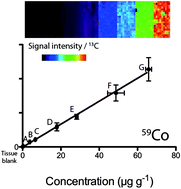Trace amounts of some metals can have highly toxic effects on diverse life forms. Furthermore, over accumulation of other metals can give rise to various diseases. Quantitative imaging techniques such as laser ablation-inductively coupled plasma-mass spectrometry (LA-ICP-MS) can help identify changes in metal content in biological materials. The versatility of LA-ICP-MS however, is somewhat limited as calibration accuracy and precision are largely dependent on the sample matrix used. Hence, acquiring reliable data can be a challenge due to the lack of well characterized reference standards.

Calibration Procedure Using LA-ICP-MS
To address this issue, Philip Doble and colleagues from the University of Melbourne, Australia, have developed a “general guide” to creating matrix-matched standards to monitor trace metals in brain tissue.
Learn more about this research by accessing the link below. This paper will be free to read until April 2nd.
Protocol for production of matrix-matched brain tissue standards for imaging by laser ablation-inductively coupled plasma-mass spectrometry
Dominic J. Hare , Jessica Lear , David Bishop , Alison Beavis and Philip A. Doble
Anal. Methods, 2013, Advance Article
DOI: 10.1039/C3AY26248K










